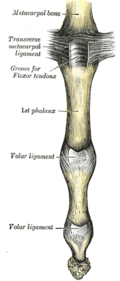Finger joints
The finger joints denote the joints between the individual finger members ( phalanges ). A distinction is made between metacarpal joints and metacarpal bones (a special form of which is the metacarpophalangeal joint of the thumb ) and the metacarpophalangeal joints between the phalanxes.
Metatarsophalangeal joints
Depending on the number of fingers, there are a total of five metacarpal joints, which are systematically numbered starting with the thumb. Anatomically speaking , the metacarpophalangeal joints II-V are ball joints ( Articulationes spheroideae ) in which the outwardly curved (convex), longitudinally oval joint head of the metacarpal bone is inserted into a corresponding inwardly curved ( concave ) pit at the end of the base phalanx closer to the middle of the body is stored. The turning movements ( rotations ) are, however, severely restricted. The metatarsophalangeal joints are surrounded by a flaccid joint capsule . In the flexed state also hardly Abspreizbewegungen (are abduction ) possible because the fingers in flexion ( flexion approach) and mesh with each other. Therefore, the metacarpophalangeal joints are functionally speaking Eigelenke ( Articulationes elipsoideae ).
In the ungulates , the metatarsophalangeal joints are called the fetlock joint .
Metacarpophalangeal joints (II – V)
The metacarpophalangeal joints of the second to fifth finger ( Articulationes metacarpophalangeal II-V , or "MCP II-V" hereinafter), the articulated connections between the metacarpal bone ( metacarpal ) of the metacarpal ( metacarpus ) and the middle of the body nearer ( proximal ) finger members ( Phalanges proximales ossis digiti ), the so-called basic phalanxes. They are also known colloquially as the knuckles .
Metacarpophalangeal joint (I)
The metacarpophalangeal joint of the thumb ( Articulatio metacarpophalangealis pollicis or also Articulatio metacarpophalangealis prima , abbreviated: "MCP I") is the articulated connection between the first metacarpal bone ( Os metacarpale I or Os metacarpale pollicis ) and the phalanx of the thumb ( phalis or proximal phalanx ) . Phalanx proximalis ossis digiti pollicis ). It is a hinge joint .
Middle and finger joints
As Fingermittel- and distal interphalangeal joints ( interphalangeal joints ) refers to the articulated connection between the closer to the middle of the body, the body more remote center and intermediate bone of the phalanges ( phalanges proximal , phalanges distal and phalanges intermedia ). These are hinge joints with a tight joint capsule, which is also reinforced at the rear by a tendon plate ( dorsal aponeurosis ). The fingers II – V each consist of three phalanges, so there are two joints between them. A distinction is made between middle finger joints ( Articulationes interphalangeales proximales , PIP) and finger end joints ( Articulationes interphalangeales distales , DIP). The abbreviations DIG (distal interphalangeal joint) for the finger end joints and PIG (proximal interphalangeal joint) for the middle finger joints are also used. The thumb has only one end of the finger because it only has two phalanges.
Arthrosis of the long finger end and middle joints are very common, but rarely painful or disabling. The arthrosis of the end joints is called Heberden's arthrosis , that of the middle joints as Bouchard's arthrosis . There are also endoprostheses for the middle joints .
Tapes
The metacarpophalangeal and terminal joints of the fingers are each secured by similar ligament complexes. Each finger joint has two collateral ligaments ( ligamenta collateralia ), which run obliquely from the rear part of the phalanx to the front part of the phalanx. They are tense when they are flexed, so that the metacarpophalangeal joints can no longer spread apart. Two additional ligaments ( ligamentum collaterale accessorium and ligamentum phalangoglenoidale ) are located on the back of the hand and originate from the tendons of the extensors . They are always tense and limit the stretching ( extension ). On the palms ( palmar tendons of the finger flexors (drag) flexors ) along and will be supported by the fibrocartilaginous front finger ligaments ( ligaments palmaria digiti padded) against the bone. The tendons are surrounded by tendon sheaths , which in turn are reinforced by elongated ring ligaments ( Ligamenta anularia digiti , A1 – A5) and cruciate ligaments ( Ligamenta cruciata digiti , C1 – C3); Gaps between these ligaments allow flexion. There are also oblique metacarpal ligaments ( Ligamenta metacarpalia tranversa profunda ), which represent a cross connection between neighboring metacarpal joints and have a superficial correlate.
swell
- Adolf Faller (first name), Michael Schünke : The human body - introduction to construction and function. 15th edition. Thieme Verlag, Stuttgart 2008, ISBN 978-3-13-329715-8 .
- E. Lütjen-Drecoll, Johannes W. Rohen, Chihiro Yokochi: Human anatomy. 6th edition. Schattauer Verlag, 2006, ISBN 3-7945-2430-6 .
- W. Platzer: Pocket Atlas of Anatomy in 3 volumes. Volume 1: musculoskeletal system. 9th revised edition. Thieme Verlag, 2005, ISBN 3-13-492009-3 .
- Michael Schünke, Erik Schulte , Udo Schumacher : Prometheus - General Anatomy and Movement System. 2nd revised edition. Thieme Verlag, Stuttgart 2007, ISBN 978-3-13-139522-1 .

